How to make a sourdough starter
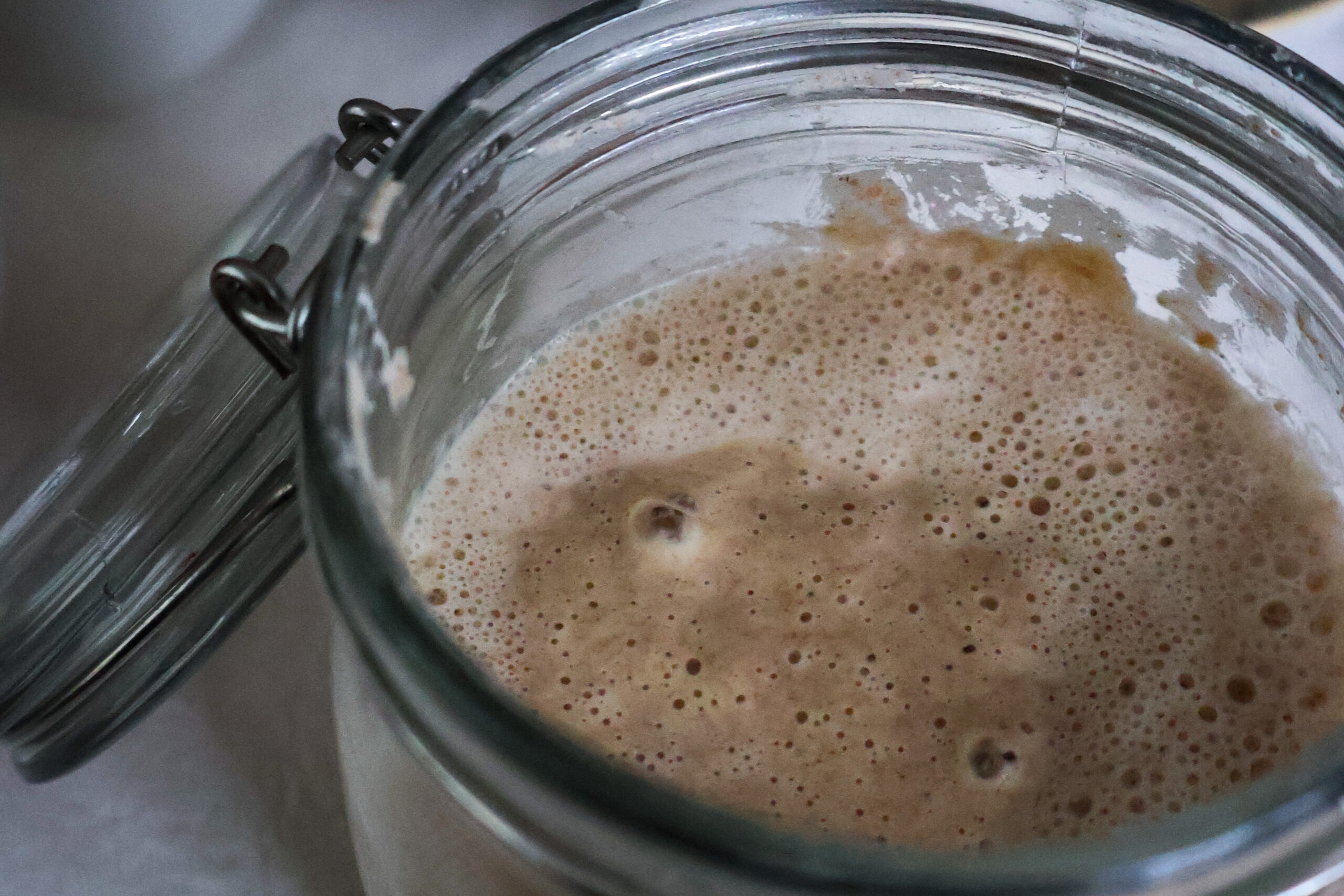
Make your sourdough starter from scratch without unnecessary throwing away, weighing and completely stress-free.
Making a sourdough starter doesn't have to be a difficult task at all! If you haven't yet come across a method that convinces you that making your own sourdough starter is simple, then read on! In this article, I'll show you the easiest method for making a bubbly sourdough starter! All you need is good quality flour, water and in a few days you'll have a full jar of active bubbling sourdough starter ready for your sourdough baking! This method is more than versatile, but today we'll make it with wheat flour.
Sourdough starter can be used in many ways and maybe more than you'd expect!
You don't have to use sourdough starter just for baking bread! It is so versatile and for me already in my home kitchen an ABSOLUTE FAVORITE thing! Sourdough starter can be used everywhere where you use flour - it helps you achieve the best cakes, buns, yeast-leavened pastries, even homemade pasta or helps you quickly thicken soup! Start a sourdough starter and join me in my kitchen to explore what you can create with sourdough!
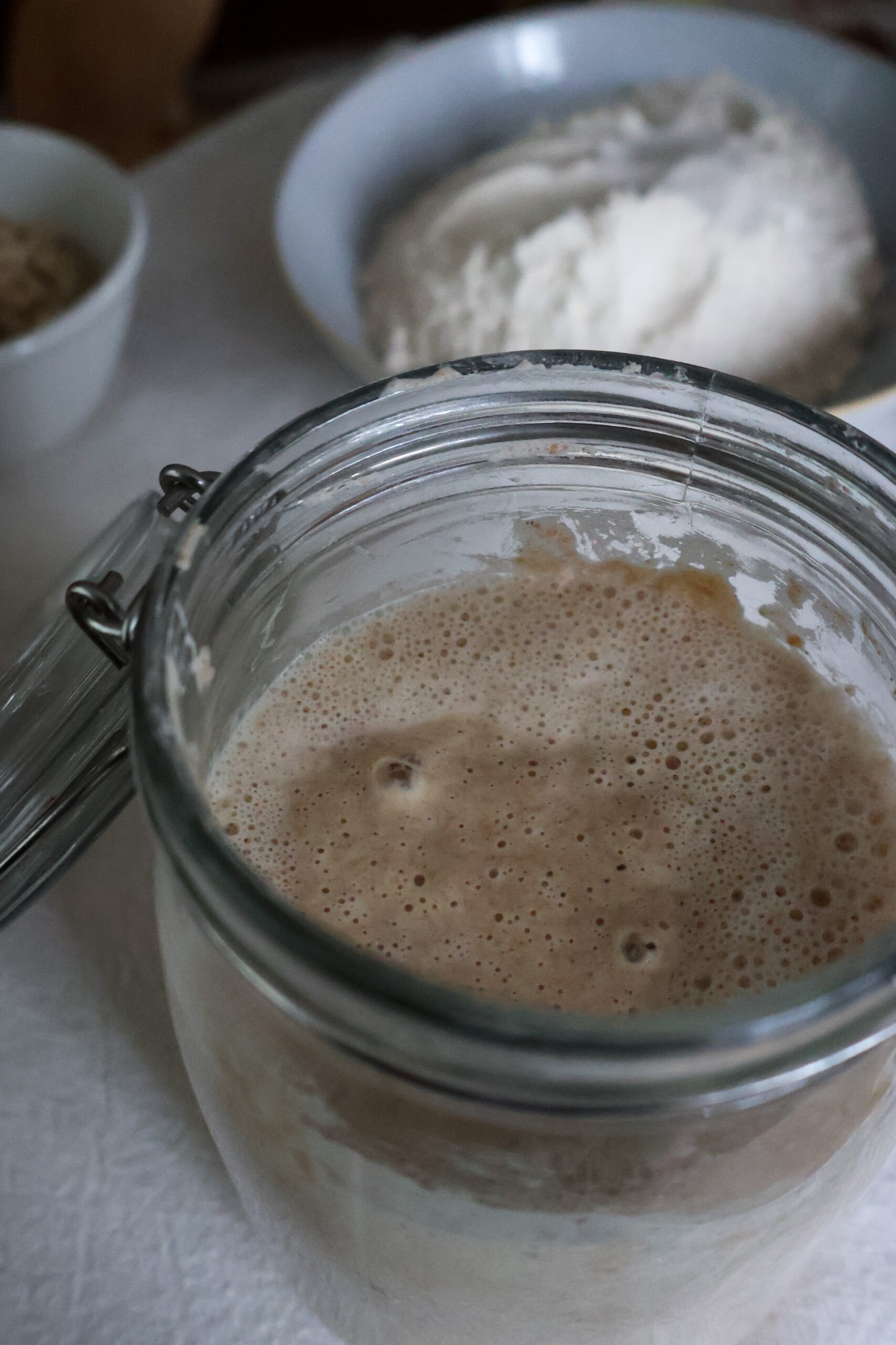
What is a sourdough starter?
Sourdough is basically fermented flour, that is made by mixing flour and water. Over time, bacteria and yeast from the air start to get trapped in this mixture, making sourdough a little vital organism. These bacteria and yeasts feed on the flour and produce CO2, which creates the sourdough starter's wonderful bubbles. But don't be confused, sourdough starter can do much more than just bubble nicely! Read on!
Why make a sourdough starter?
Before yeast was invented and sourdough baking became easier, faster and more reliable, it relied entirely on natural fermentation. And one of these is simply the sourdough starter made from flour. In addition to leavening the dough and making it fluffy, it also, and this is important, helps to eliminate phytic acid from the grain.
Phytic acid is an antinutrient that blocks the absorption of certain healthy substances in the grain. Understand that in nature, the plant reproduces by grain, so it needs to have as many nutrients as possible in order for the new plant to sprout. Phytic acid is not only in the grain of wheat, rye and other grains. It is also found in legumes, nuts and some fruits.
Fermented flour therefore has a lower (if not none) phytic acid content, allowing our bodies to take in as many of the nutrients, that grains have to offer. But that's not everything though!
Fermented flour also has a lower glycemic index, which means that glucose doesn't rise as quickly and we feel fuller for longer.
Last but not least, sourdough bread has an absolutely amazing flavor and is quite resistant to mold. So it can be stored much longer than yeast products. Properly baked sourdough bread will keep for up to a week in an optimal environment, it just dries out over time.
In recent years, however, there is a new reason why people want to bake with sourdough starter.
In today's busy life, lots of people are looking for a way to slow down and relax, so they start to bake with sourdough starter. It makes sense, because you can't speed up sourdough baking! And so you have to tune in to its slow pace. Plus, working with dough can be incredibly relaxing for someone! So if you're also trying to slow down and bring a little nostalgic spirit into your home, then sourdough might be the perfect thing for you too!
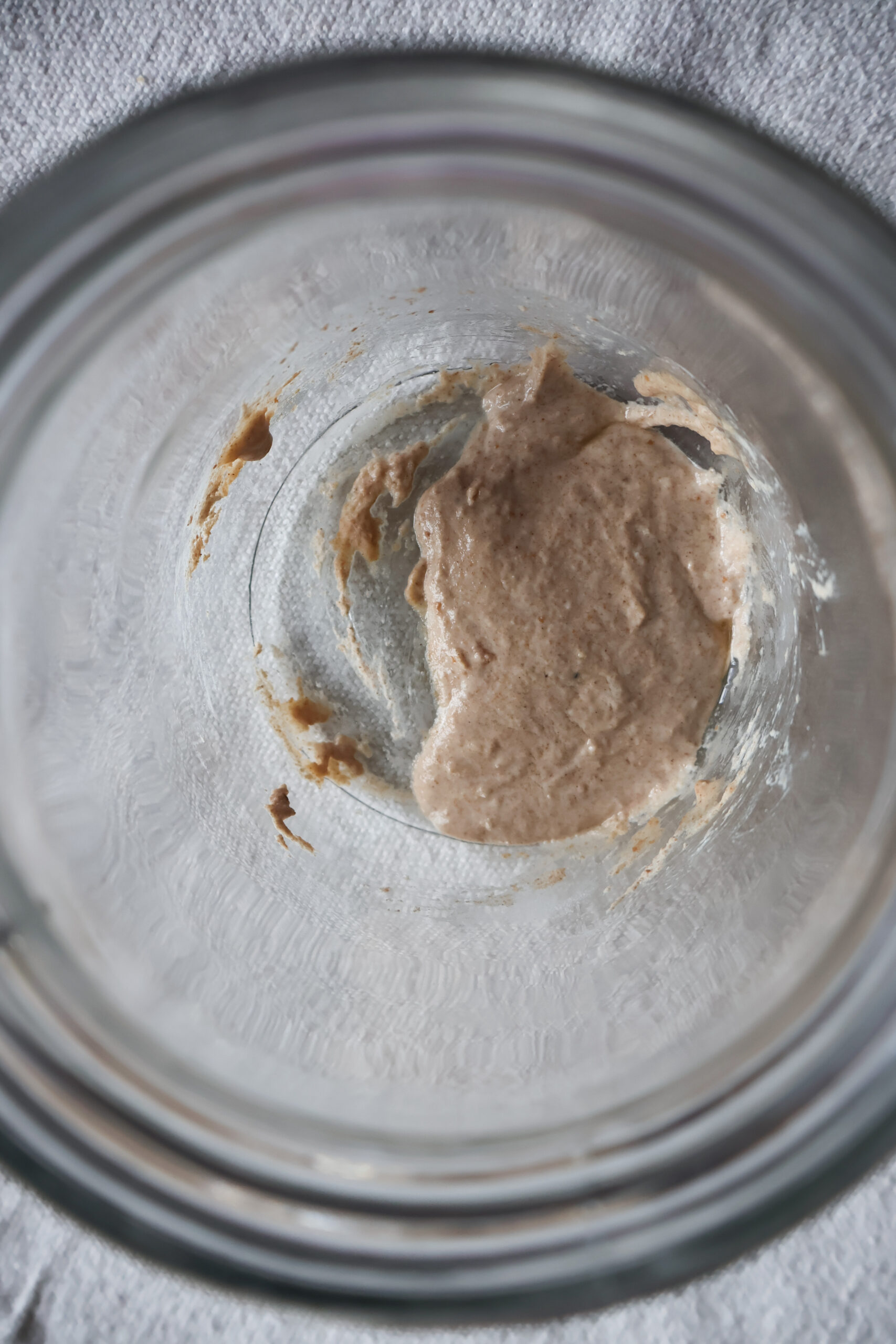
What do we need to start the sourdough starter?
This method is simple and easy. All you need is flour, water and it can also be tap water, a large clean glass jar with a minimum capacity of 1.1 liters and a spoon..
What flour to use to make wheat sourdough starter?
You can use basically any wheat flour for the starter. But let's see which types are the best.
- Freshly ground flour - Ground wheat or spelt are both great options! Freshly milled grain has the greatest likelihood for fermentation because it better traps bacteria and yeast from the surrounding area.
- Whole wheat flour from the store - it's perfectly fine to start a starter with either whole wheat or spelt flour. I still recommend buying the freshest flour you can find.
- AP flour - actually, you can get a sourdough starter from white AP flour, it's just probably the least suitable flour for starters. A better option is to make your starter with wholemeal flour and then feed it with white wheat flour. Wholemeal flour again contains more nutrients for the bacteria and yeast as it also contains a certain amount of hull and germ.
How long does it take to make a wheat sourdough starter?
Making a sourdough starter is more time consuming and even that can often be discouraging, but it goes by very quickly! What's more, you only need to start it once! A stable active wheat sourdough starter is ready in approximately 5 days.
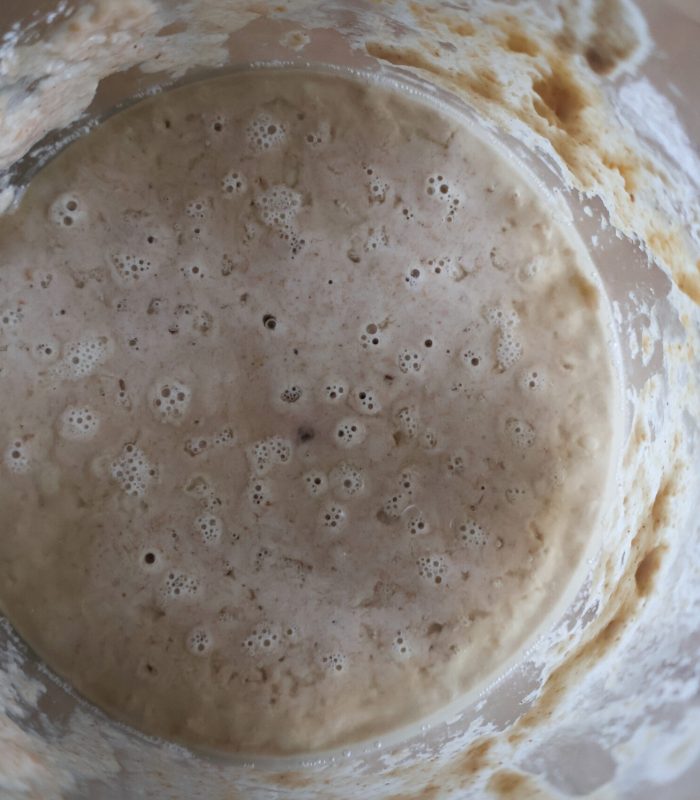
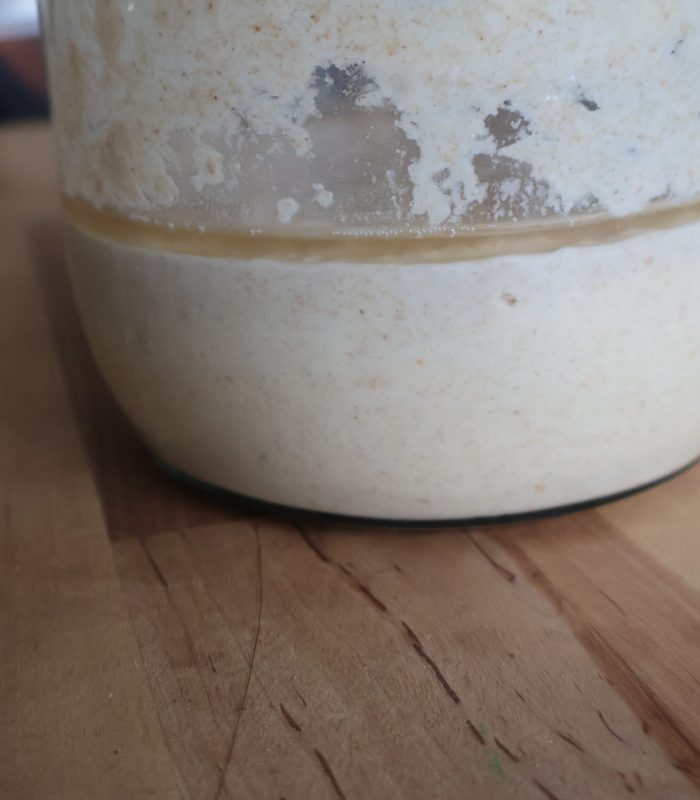
During the fermentation process you may even see some water on the surface - this is when the yeast is getting hungry
How to make a wheat sourdough starter?
With my sourdough starter method, you can get about a liter of sourdough starter in 5 days, with absolutely no throwing away and no measuring! A liter of sourdough starter may still seem like too much for some, and if you're a beginner, you may not know what to do with it! That's why at the end of this article you'll find my tips for using up the resulting sourdough starter and, of course, instructions on how to continue feeding it and keeping it vital!
One more small but important note... Five days is quite a long time, so don't just rely on your memory! I recommend keeping a piece of paper next to your sourdough starter and writing notes in it, especially the date of feeding and the amount of feeding. It seems trivial, but it is very helpful! Especially if your life is a little more busy! That's why I've added a cute little chart into my printable instructions and I hope it makes your sourdough starter making a lot easier! :))Five days is quite a long time, so don't just rely on your memory! I recommend keeping a piece of paper next to your sourdough starter and writing notes in it, especially the date of feeding and the amount of feeding. It seems trivial, but it is very helpful! Especially if your life is a little more busy! That's why I've added a cute little chart into my printable instructions and I hope it makes your sourdough starter making a lot easier! :))
You need to feed the sourdough starter every day and ideally at the same time of day (morning, afternoon or evening).
Day 1 - Prepare a large clean jar or container with a lid with a minimum capacity of 1.1 liters. Next, use a clean spoon and prepare enough flour for feeding. Place 1 tbsp of flour and 1 tbsp of water in the prepared jar.
If you have freshly ground flour, it is better to use heaped spoons, while if you have store-bought flour, it is better to use level spoons. At this stage, see how much your flour absorbs and add a little water or flour as needed to achieve a thick oatmeal-like consistency.
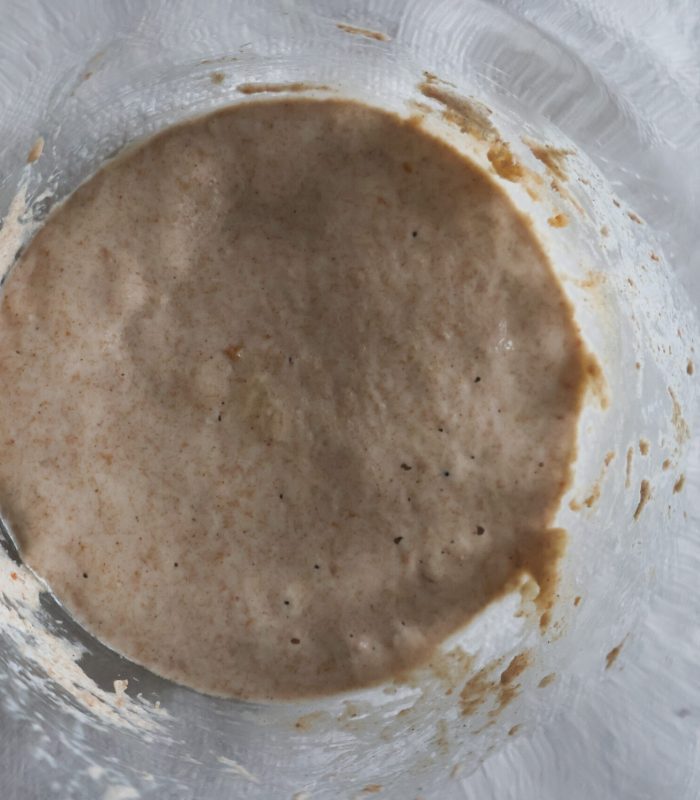
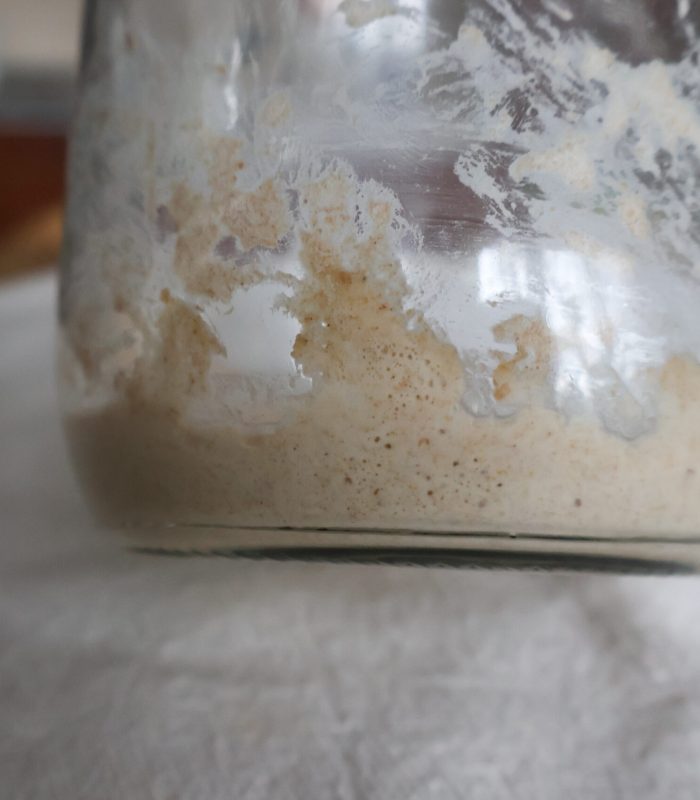
Approximately in 2-3 days you will have small bubbles in the sourdough starter.
Day 2 - The sourdough starter at this stage smells like pancake batter and does not ferment - add 2 tbsp flour and 2 tbsp water. You now know how much your flour absorbs water, so it will be easier for you to estimate the amount of water to achieve that oatmeal-like consistency again.
Day 3 - The sourdough has a little bubbles but still smells like pancake batter - slightly sweet and a little nutty. Add 4 tbsp of flour and 4 tbsp of water and stir again until the desired consistency.
Day 4 - The sourdough at this stage already has noticeable bubbles and smells like kefir or sour cream, so like a milky and sour smell. This time add 8 tbsp flour and 8 tbsp water and stir.
Day 5 - On the surface of the starter the water may start to separate , this is a sign that the starter is already active and in this case hungry. It smells sourly of vinegar and has a lot of bubbles on the surface. Feed the yeast with 16 tablespoons of flour and 16 tablespoons of water. It will seem like a lot at first, but there are a lot of bubbles in the sourdough and it will drop again after stirring. I ended up with about half a jar of starter after adding the flour.
You can also put a rubber band on the jar to check if your sourdough is really rising and bubbling. The starter is most active when it is about twice its volume.
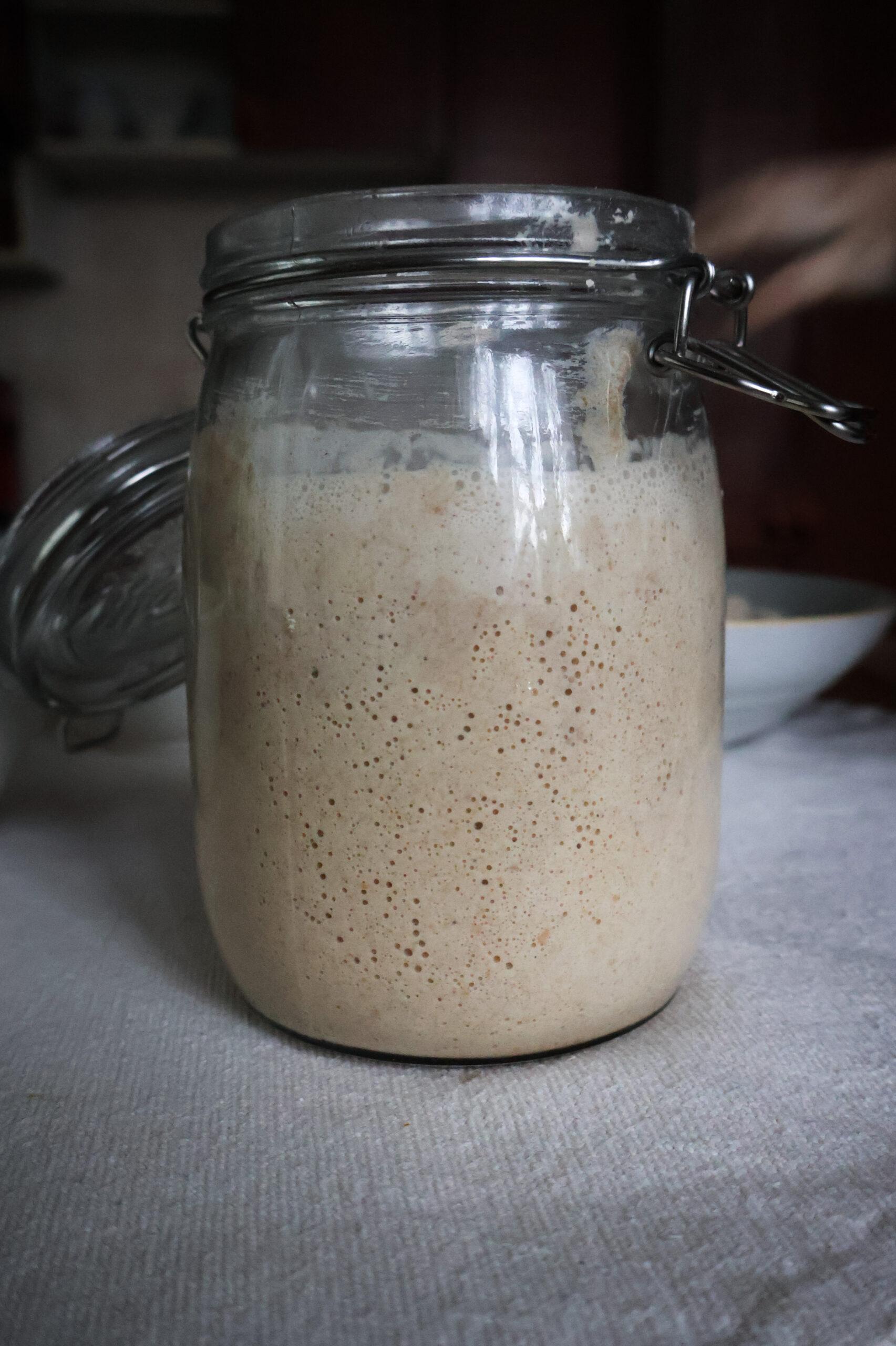
What to make with a lot of sourdough starter?
So now you have about a liter of active sourdough starter ready and you are wondering how to process it. Here are some tips on how to use it.
The best recipes for quick using of large quantities of sourdough:
- Easy sourdough biscuits
- Sourdough pancakes with blueberry sauce
- Sourdough crepes
- Sourdough lemon poppy seed cake
- Sourdough cheese waffles
Let's try some of that bread right away! Active sourdough starter can also be used instead of levain:
- Wheat sourdough bread
- Sunflower seed sourdough bread
- Buttery sourdough sandwich bread
- Seeded bread - sourdough bread for beginners
- Sourdough tortillas with spelt flour
You can find more recipes HERE in the Sourdough section 🙂
How to feed sourdough starter?
I have already written a whole article on this topic and I am sure you will find everything you need to know there! Check it out HERE, where I show you a step-by-step tutorial on my easy method of keeping sourdough starter with no throwing and no measuring!
Video instructions:
Instructions
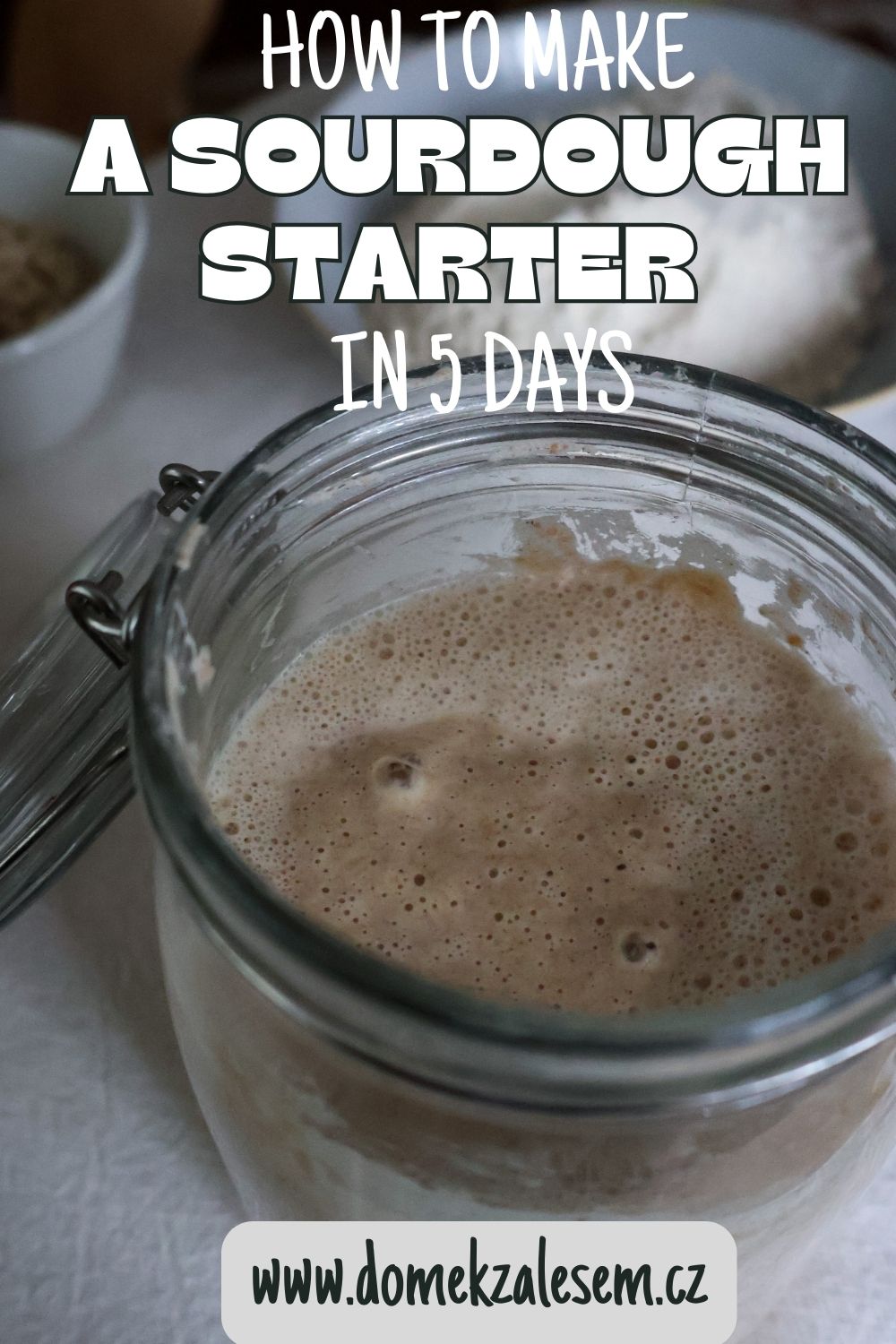
approx. 1 liter
How to make a sourdough starter
We need:
- whole wheat flour (can be spelt flour)
- water
- a spoon.
- a jar with a lid with a capacity of at least 1.1 l
Instructions:
- Day 1 - Put 1 tbsp of flour (leveled) and 1 tbsp of water (can be from the tap) into a clean jar and stir until thick. A little extra flour or water can be added as needed to give the mixture the right consistency. Cover with a lid but do not seal to allow air to flow to the mixture.
We will continue to feed the sourdough starter at the same time of day - either in the morning, afternoon or evening.
Day 2 - Add 2 tbsp of flour and 2 tbsp of water to the jar, stir and again leave the lid on just enough to allow air to flow to the mixture.
We'll continue to feed our future sourdough starter in the same way, just adding more flour.
- Day 3 - Add 4 tbsp flour and 4 tbsp water.
- Day 4 - Add 8 tbsp flour and 8 tbsp water.
- Day 5 - At this stage, the sourdough starter should be quite active and can be used for leavening bread. For more stability of the starter, I recommend one more addition. So add 16 tbsp of flour and 16 tbsp of water and let it ferment for another 24 hours.

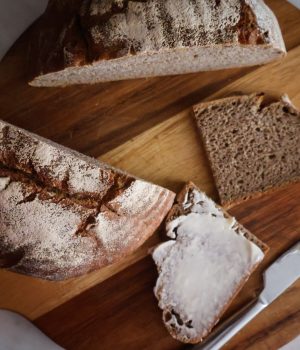
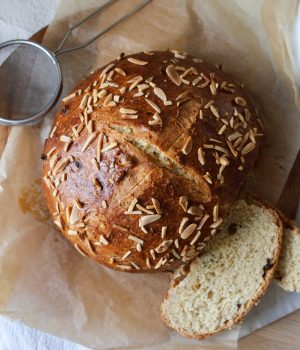
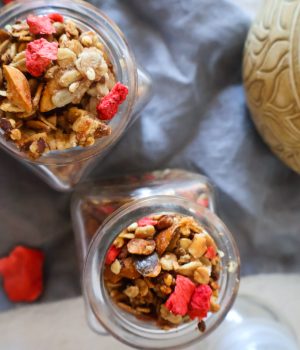
Dobry den, mohu se prosim zeptat? Poprve zakladame psenicny kvas, a po patem dni se nezmenila hladina kvasu. Je stejna jako vcera. To je asi spatne. Predem dekuji, nashledanou JaM Buresove
Dobrý den, hladina se pátý den ještě měnit nemusí, důležitým znakem je vůně a přítomnost malých bublinek. Pokud máte pocit, že je něco špatně, můžete zkusit založit kvas znovu a doporučuji vyzkoušet jinou vodu. Někdy může být v kohoutkové vodě příliš chloru, který kvasinkám nesvědčí. 🙂
Dobre, dekuji! Preji pekne dny. Nashledanou J. Buresova
Dobry den, mohu se prosim zeptat?Zapomela jsem vecer dokrmit kvas. Tak jsem rano dokrmila. Pak jsem se rozhodla opet zacit unovu. Jen by me zajimalo, jak nejdele muzu mezi krmenim kvasu vynechat? Predem dekuji za odpoved. Pekny den nashledanou J. Buresova
Dobrý den, pokud zapomenete kvas nakrmit, je dobré to udělat ihned co si vzpomenete. Jestli máte již aktivní kvas na dokrmování a chcete jej udržovat aktivní někde na lince v kuchyni, je dobré ho krmit každý den. Pokud jej dáváte do ledničky na zpomalení kvašení tak jej stačí krmit 1x za 3-5 dní, podle potřeby a toho, jak často pečete. Nevím, jak dlouho přesně je maximum času mezi krmeními. Běžně nechávají kvas klidně 2 týdny bez krmení v lednici. Obecně, pokud tam není plíseň, tak se dá vždycky znovu rozjet.
Dobry den, dekuji za odpoved😊nashlednou J.B
Dobry den, pri zakladani kvasku se neco nevedlo uplne nejlepe. Paty den se hladina nemenila, kvasek nerostl. Sesty den jsem zapomela dokrmit vecer. Dokrmila jsem rano, ale to taky hladinu nemenilo. Nevadi, ted odlozim kvaskovani, a mozna nekdy vyzkousim. Dekuji za podporu. Rodina a prace me davaji zabrat, tak zapomenu, nebo zmeny a td ;o))))))))) Dekuji;o))))) Nashledanou J.Buresova
Dobrý den, škoda, že se vám kvásek nevyvedl. Jestli budete příště zakládat, moc doporučuji si k němu udělat na papírek tabulku, kde budete mít přehled krmení. V takových hektických dnech se to velmi hodí. 🙂
Dobrý den, mockrát děkuji za krásná inspirativní videa. Úplně jste mě kváskováním nadchla. Už jsem před pár lety kvásek zakládala, ale nikdo mi neukázal cestu, jak ho všestranně využít. Vaše videa jsou tak poklidná a milá. Děkuji za ně i Vaše tipy!!!
Hezký den, Moc děkuji za krásný komentář. 🙂 Jste zlatá! Přeji, ať se vám kváskování jen daří.
Ahoj, v neděli jsem dle návodu zalozila pšeničný kvásek. Dnes je to 4 den a zatím se mi nedělají žádné bublinky. Chci se zeptat jak pokračovat a kolik dále krmit aby se proces rozjel. Děkuji za info. Gábina
Já bych zkoušela krmit dál. Ovšem pokud se vám do 4 dnů neobjevily bublinky, zamyslela bych se nad kvalitou a typem mouky, kterou používáte. Na kvas je nejvhodnější Bio celozrnná mouka. Pokud by se bublinky nerozjely, tak bych určitě vyzkoušela jinou mouku, popř. můžete založit žitný kvas (ten kvasí rychleji) a poté si ho překrmit na pšeničnou mouku. Zvažte také, jestli máte budoucí kvásek na místě se stálou teplotou, nebo jestli není v průvanu. Přeji ať se kvásek zadaří.
Dobry den, kvasek jsem zalozila v sobotu vecer a postupovala podle pokynu. V pondeli odpoledne jsem si vsimla, ze se v pulce rozdelil a je tam voda. Zamichala jsem a vecer Nakrmila 8+6 vody. S tim, ze je ji tam asi moc. Rano se ale zase v pulce udelala voda. Hezky voni a ma velke bubliny. Stalo se Vam to nekdy?
Pouzila jsem Pernerku Bio Spaldovou celozrnnou hladkou.
Dekuji
Dobrý den, u pšeničného kvasu je výskyt oddělené vody zcela běžný. Většinou se dělá, pokud máte v bytě tepleji. Oddělenou vodu buď zamíchejte zpět nebo ji vylijte. 🙂
Dobrý den,
Chtěla jsem se zeptat, kdy je kvásek ve své největší síle? Děkuji
Dobrý den,
Chtěla bych se zeptat, jestli je možné si kvásek založit z poloviční dávky, pro mě jako začátečníka? 😊 Tudíž první den 0.5 PL mouky + 0.5 PL vody, druhý den 1 PL mouky a vody a tak dále další dny? Bude to fungovat?
Předem moc děkuji za odpověď a děkuji za skvělé příspěvky. 😊
Ano, kvásek lze založit i z poloviční dávky. :))
Dobrý den, máte moc hezky zpracované povídání o kvásku. Jsem začátečník a chtěla bych použít kvásek na koláče klasika z bílé mouky. Jaký nejlépe připravit kvásek ? Děkuji moc za odpověď. Růžena
Dobrý den,lze na založení kvásku použít pšeničnou chlebovou mouku? A dale s ní dokrmovat. Jak postupovat aby prezil dovolenou,aniz bych ho musela ho nekomu sverit aby se o něho nekdo staral?Děkuji
Ano můžete použít i pšeničnou chlebovou mouku, ale nejlepší výsledky získávám s moukou celozrnnou. Kvas můžete buď hodně zahustit a nechat v lednici a nebo ho tam nechat jen tak v zavřené nádobě. U pšeničného kvasu se vám za nějakou vodu akorát uvolní taková voda, která po čase zgelovatí, někdy i zčerná. Tu po dovolené před krmením odstraníte a můžete přikrmovat jak jste zvyklí.